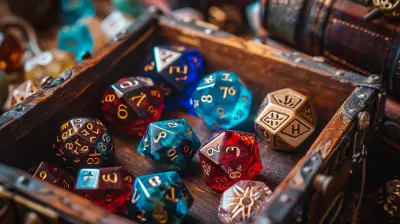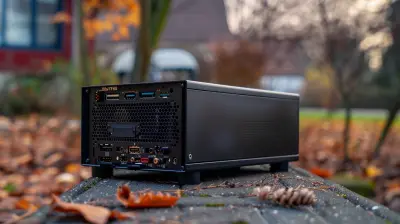Perfecting Your Timing in Rhythm Games
23 May 2025
Ever felt like you’re dancing to your own beat, only to find out it doesn’t sync with the game? Rhythm games can be an absolute blast, but if your timing is off, it can quickly spiral into frustration. Whether you're tapping notes in Osu!, smashing arrows in Dance Dance Revolution (DDR), or jamming to beats in Beat Saber, the secret sauce to success is nailing your timing. So, how do you go from "meh" to mastering the beat? Don't worry, I’ve got you covered. Let’s dive into strategies, hacks, and tips to perfect your timing in rhythm games. 
What Are Rhythm Games?
Before diving headfirst into the tips, let’s make sure we’re on the same (musical) page. Rhythm games are music-driven experiences where you interact with beats, notes, or cues in time with a song. They demand precision, quick reflexes, and, most importantly, rhythm. The better you sync to the music, the higher your score. Mess up the timing, and… yeah, game over.
Why Timing Matters
Timing is everything in rhythm games. It’s the bread and butter, the peanut butter to the jelly of gameplay. Hit a note too early or too late, and you're not just losing points—you’re breaking the flow. Imagine you're a drummer in a band, and you're offbeat. The whole performance sounds off, right? It's the same with rhythm games. Good timing equals a satisfying gaming experience, while bad timing can feel like trying to dance with two left feet.
How to Perfect Your Timing in Rhythm Games
Let’s break it down. Whether you’re a beginner trying to hit those first few notes or an experienced player looking to conquer the hardest difficulty, these tips will help you sharpen your skills.1. Know Your Game
Every rhythm game has its own unique mechanics. Some might require precise taps, others swipes, and some even full-body movements. Before diving in, take time to understand the gameplay. Watch tutorials, read guides, or just spend a few minutes in the practice mode. Learning the rules and mechanics is like warming up before a workout—it sets the stage for success.2. Calibrate Like a Pro
This might seem basic, but it’s super important. Most rhythm games let you tweak settings like input latency or audio sync. If the timing feels “off” even when you’re sure you’re nailing the beats, it could be a calibration issue. Spend some time adjusting the audio and visual lag settings. It’s a one-time setup that makes the difference between "pretty good" and "unstoppable."3. Find Your Rhythm (Literally)
Ever heard the phrase “feel the beat”? This isn’t just vague advice—it’s legit. Lean into the song’s rhythm, and try to “feel” when the notes are coming. Bob your head, tap your foot, or even hum along. The more you physically connect with the music, the easier it is to internalize the timing. Think of yourself as a conductor leading an invisible orchestra.4. Practice Makes Perfect
If you’re expecting to ace a rhythm game without practice, well, hate to break it to you—it’s not gonna happen. Like playing an instrument or learning to dance, rhythm games require repetition to build muscle memory. Start on an easier difficulty and work your way up gradually. Don’t be afraid to replay the same song multiple times. Repetition won’t just improve your timing; it’ll boost your confidence, too.5. Use Visual Cues
Many rhythm games use visual indicators to guide your timing, like scrolling notes or pulsating beats. Use them! Pay close attention to how notes or arrows line up with specific targets on the screen. While you don’t want to only rely on visuals (the beat is important, too), they’re an excellent training wheel while you get the hang of it.6. Listen Closely
Okay, this one seems obvious, but hear me out—no pun intended. Rhythm games are all about the music, so listening is key. Focus on the beat, the tempo, and the rhythm patterns. If you’re struggling, pop on a pair of noise-canceling headphones. This helps block out distractions and allows you to fully immerse yourself in the song. No distractions = better focus.7. Improve Your Reflexes
Timing in rhythm games isn’t just about feeling the beat—it’s also about lightning-fast reactions. If you struggle with hitting notes in time, it might be worth working on your reflexes. Mini-games and apps designed to speed up your reaction time can actually help here. Think of it as training your hands to keep up with your brain.8. Don’t Be Afraid to Take Breaks
Burnout is real, even in rhythm gaming. If you find yourself getting frustrated or stuck on a particular song, step away for a bit. Grab some water, stretch, or just vibe to the music without the game. Coming back with fresh eyes (and ears) often works wonders. It’s like hitting a “reset” button on your brain.9. Experiment With Control Layouts
Are you using the default controls? You might want to reconsider. Some rhythm games allow you to customize your control layout, and finding a setup that feels natural to you can be a game-changer. Whether it’s adjusting button positions or experimenting with touch vs. physical buttons, the goal is comfort and precision.10. Stay Consistent
Consistency is one of the most underrated aspects of rhythm gaming. It’s not just about hitting a single note perfectly—it's about hitting every note in a row. Stay focused, maintain your rhythm, and don’t let a single mistake throw you off. Remember, rhythm games reward steady performance over flashy moves.11. Challenge Yourself
Once you’re comfortable with your timing, don’t be afraid to crank up the difficulty. Higher levels push you to respond faster and train your precision. Sure, you’ll fail a bunch at first, but that’s part of the process. Think of it like leveling up in a video game. Each failure is just another step toward mastery.12. Learn From Others
Sometimes seeing how others play can spark an “aha!” moment. Watch pro players or streamers, and pay attention to their timing, techniques, and strategies. You might pick up a few tricks you hadn’t considered before. Plus, it’s pretty inspiring to see the insane skill level some players have!
Common Pitfalls and How to Avoid Them
Even the best players stumble now and then. Here are some common mistakes and quick fixes:- Overthinking the Notes: Try not to analyze too much—just let it flow.
- Ignoring the Music: Don’t tunnel vision on the screen. Listen to the beat!
- Skipping Calibration: Always double-check your settings before starting.
The Zen of Rhythm
At its core, rhythm gaming is about enjoying the music and syncing with the beat. When you stop stressing over every note and start flowing with the rhythm, you’ll notice huge improvements in your timing. It’s almost like meditating—but instead of sitting still, you’re jamming to epic tracks!Final Thoughts
Perfecting your timing in rhythm games is more than just skill—it’s about connecting with the music and staying dedicated to practice. Sure, you might mess up a hundred times before you get it right, but that’s the beauty of it. The more you play, the better you get. And let’s be real—nothing beats the satisfaction of hitting a flawless combo on your favorite song.Now, go out there and dominate those beats!
all images in this post were generated using AI tools
Category:
Gaming TipsAuthor:

Leif Coleman
Discussion
rate this article
4 comments
Quill Graham
“Timing is everything in rhythm games—just like knowing when to hit the snack table during a gaming marathon. Miss one beat, and you might end up with a face full of nachos!”
June 12, 2025 at 3:29 AM

Leif Coleman
Absolutely! Timing is crucial in rhythm games, just like balancing gameplay with snack breaks. Master both for a seamless gaming experience!
Paul McGowan
“Great tips! Timing is everything in rhythm games. I love how a well-timed beat can transform a good play into an unforgettable one! Keep grooving!”
June 1, 2025 at 4:57 PM

Leif Coleman
Thank you! I'm glad you enjoyed the tips. Timing really does elevate the experience—keep grooving and hitting those beats!
Isla McMichael
In the dance of beats and echoes, timing is the heartbeat of the game. Each tap, a whisper; each slide, a breath. Mastering the rhythm, we transcend the notes, crafting our own symphony of precision and grace. Let the music guide you!
May 29, 2025 at 3:49 PM

Leif Coleman
Thank you! Beautifully expressed—timing truly is the essence of mastery in rhythm games. Let’s keep dancing to the beat!
Rhea McElveen
Great insights! Timing truly makes all the difference in rhythm games.
May 24, 2025 at 4:48 AM

Leif Coleman
Thank you! I'm glad you found the insights valuable. Timing is indeed crucial for mastering rhythm games!



